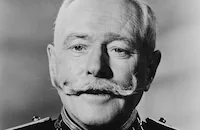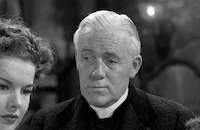The Man Who Dared
Cast & Crew
John Sturges
Leslie Brooks
George Macready
Forrest Tucker
Charles D. Brown
Warren Mills
Film Details
Technical Specs

Synopsis
Donald Wayne, a newspaper columnist known for his outspoken criticism of court convictions resulting from circumstantial evidence, finds himself on trial for the murder of gangster Andrew White. During the trial, Darrell Tyson, the district attorney, calls Andrew's fiancée, Lorna Claibourne, to the witness stand. Lorna believes that Donald is innocent, but Tyson elicits enough damaging testimony from her to strengthen his case against Donald. When the prosecution rests its case, Donald's lawyer forgoes the opportunity to present a case on behalf of his client, and instead argues that the case against Donald has been based solely on circumstantial evidence. While the jury deliberates the case, Donald confides in his lawyer and Lorna that he deliberately set himself up for the murder charges to show how easy it is to convict an innocent man with circumstantial evidence alone. Donald then reveals that years earlier, he had spun a tale of circumstantial evidence around Jack Ellison, an innocent man who was sent to prison as a result of Donald's actions. Donald then tells the story of how he came to be charged with murder: In an attempt to clear Ellison of damning charges made by White, a gangster informer, during Ellisons' trial, Donald goes to White's home, arriving moments after White has been shot. In his last moment of life, White points to a letter he wrote naming racketeer Marty Martin as his killer. Donald quickly hides the letter and fires his gun, a sound that he knows will be heard by Lorna, who is waiting for him outside. Donald then tells his friend, Larry James, about his hoax, and establishes a trail of circumstantial evidence pointing to himself as the killer. Tyson, unable to produce another suspect, charges Donald with first degree murder. As Donald comes out of his reverie, he learns that the jury has delivered a guilty verdict. Donald then reveals his hoax, and promises to produce evidence that will prove that Martin is the killer. Complications arise, however, when Larry, who has been sent to retrieve White's note from Donald's safe deposit box, is abducted by two gangsters in the employ of Martin. After taking the note from Larry, the gangsters run over Larry with their automobile and leave him for dead. While Larry lies comatose in the hospital, a gun purported to be Donald's is rushed to the courtroom. A ballistics expert uses the gun as evidence to confirm Donald as the killer, and Donald's conviction is upheld. One day, while being transported to prison, Donald overpowers his guard and escapes to Larry's hospital room. After Donald coaxes Larry out of his coma, Larry tells him that Martin was the one who abducted him. Donald then goes to Martin's home, where he finds evidence that Martin had switched the barrel of Donald's gun with his own. The new evidence exonerates Donald and proves conclusively that Martin's gun was used to kill both White and the man for whose murder Ellison was wrongly convicted. Larry eventually recovers, and Donald is satisfied that his efforts have resulted in Ellison's release from prison.

Director

John Sturges
Cast

Leslie Brooks

George Macready

Forrest Tucker

Charles D. Brown
Warren Mills
Richard Hale
Charles Evans
Trevor Bardette
William Newell
Brooks Benedict
Tom Kingston
Doris Houck
William E Lawrence
Jack Parker
Steve Benton
Harry Anderson
Dave Harper
Bob Stevens
George Lloyd
Harry Tyler
Pat O'malley
Margaret Mcwade
Arthur Space
Phil Arnold
Franklin Parker
Art Gilmore

Ralph Dunn
Jessie Arnold
Wally Rose
Joseph Palma
Crew
Mischa Bakaleinikoff
Edward Bock
Malcolm Stuart Boylan
George Brooks
James Crowe
Philip Faulkner
Seymour Friedman
James M. Goss
Alex Gottlieb
Leland Jones
Charles Nelson
Leonard S. Picker
Maxwell Shane
Philip Tannura
J. S. Westmoreland
Edwin Wetzel

Film Details
Technical Specs

Quotes
Trivia
Notes
The working title for this film was One Life Too Many. The film marked director John Sturges' first feature-length dramatic film. Prior to this film, Sturges had directed and edited many documentaries and military training films, including the 1945 film Thunderbolt (see below), which he co-directed with William Wyler. According to a January 1946 Hollywood Reporter news item, Columbia assigned Sturges to the film after William Castle, who was originally set to direct, was reassigned to The Return of Rusty (see below). The Harrrison's Reports reviewer commented on the similarily of this film to the 1935 Chesterfield production Circumstantial Evidence (see AFI Catalog of Feature Films, 1931-40; F3.0722). The theme of a man wrongly convicted of murder based on manufactured circumstantial evidence is similar to The Man Who Dared, but other aspects of the two films differ significantly.












